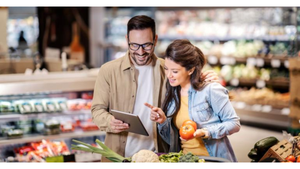The latest in retail media? In-store messaging platformsThe latest in retail media? In-store messaging platforms
Retailers are now investing in connecting brands with customers at the point of purchase
May 28, 2024

In-store media such as video display screens, audio broadcasts, and other strategically placed messaging are among the biggest opportunities for supermarket operators to grow their retail media networks.
Hy-Vee, for example, has rolled out digital screens throughout its stores, focusing on shopper “points of rest” such as the entryway, deli, pharmacy, and checkout lanes, said Kathryn Mazza, senior vice president of RedMedia, Hy-Vee’s retail media network. In center store areas, the screens are placed near aisle signage where consumers are already in the habit of looking as they navigate their shopping trips, she said.
“Our digital displays are connecting our partners with consumers closer to the point-of-purchase,” said Mazza. “They serve as an opportunity to bring awareness to new products and promotions and provide customer education on brands and products.”
In focusing on in-store messaging as part of its RedMedia network, Hy-Vee is jumping on a strategy that larger players, such as Walmart and Kroger, have been deploying with their own RMNs.
Walmart, which has cited its Walmart Connect media network as a significant growth opportunity, has been focused on leveraging its vast in-store marketing capabilities. The company said it had about 170,000 digital screens, such as those on self-checkout machines, in its 4,700 stores. The company also rolled out an in-store radio advertising platform that allows advertisers to target specific stores.
Kroger, meanwhile, in recent years has expanded its Kroger Precision Marketing retail media network to include video and closed-circuit TV. In addition, it has partnered with Cooler Screens to install smart screens on refrigerator doors that can also be used to display marketing messages.
A bigger in-store audience
For most retailers, their in-store consumer reach is much larger than their online reach, making in-store marketing platforms potentially much more attractive to advertisers, according to a recent report from financial advisory firm Solomon Partners. Walmart has a monthly audience of 212.4 million people vs. an online audience of 125.3 million, for example, according to the Solomon Partners report, citing data from Comscore and Placer.ai.
The report, which looked at media networks across all retail channels, projected that RMNs would attract $106 billion in advertiser spending in the U.S. by 2027, more than double the approximately $50 billion estimated spending in 2023.
At Northeast Grocery, parent of the Tops Friendly Markets and Price Chopper/Market 32 chains, the company has been testing a variety of in-store media opportunities, but has not yet connected them to its RMNs, said Diane Colgan, senior vice president of marketing at Northeast Grocery. It partners with its digital coupon provider, Inmar, to operate the retail media networks, which are called Tops Shopper Link and Price Chopper Shopper Link.
“We do have digital screens in a lot of our stores throughout various departments that might have anything from menu items to promotional information and new product information,” Colgan said, adding that it does have some brands that advertise on the screens.
Instacart’s in-store solution
Third-party delivery and ecommerce solutions provider Instacart, which has one of the industry’s largest RMNs, branded as Carrot Ads, has been seeking to bring its personalized marketing opportunities to the in-store environment via “smart carts.” The company recently began testing ads on its Caper Carts in Bristol Farms stores in Southern California, for example.
“With the introduction of ads on Caper Carts, we’ll soon be able to unlock a new, incremental revenue stream while offering customers valuable suggestions and promotions from our brand partners,” said Neil Stern, CEO of Bristol Farms parent company Good Food Holdings, in a statement when the agreement was announced in January.
The new ad capabilities enable CPG brands to engage with customers in-store in a more personalized way based on past purchase behavior or real-time shopping behavior, Instacart said.
Although it has not installed smart-cart technology in its stores, Northeast Grocery is among the supermarket operators that have partnered with Instacart to leverage Carrot Ads, which is Instacart’s name for its ecommerce retail media network.
Last year, Northeast Grocery expanded its partnership with Instacart, which had been providing the company with delivery services since 2017 and had been powering its ecommerce platform since 2019. The expanded partnership with Instacart allows brands to advertise directly on Tops’ e-commerce platforms and apps, and to include Price Chopper and Tops in their national campaigns through Carrot Ads.
Access to analytics
While scale is key to the ability of RMNs to attract advertising dollars, access to data analytics around ad performance is also critical.
At Hy-Vee, for example, the data and analytics offered by RedMedia have evolved significantly to meet the needs of the retailer’s CPG partners, Mazza said.
“Our reporting timelines and level of detail is what differentiates us from other retail media networks,” she said. “We offer granular insights across campaign performance and customer behavior through fully managed and self-service models.”
Likewise, Northeast Grocery’s CPG advertisers also have access to performance data and analytics, which allow them to adjust their promotional tactics on the fly or make other marketing decisions based on sales performance or other criteria. Inmar and Instacart both offer tools that advertisers can use to obtain analytic data, or the retailer can provide the data itself in some instances.
An advantage of working with Inmar for its main RMNs, Colgan said, is that because Inmar also manages the retailer’s digital coupons, it allows vendor partners to have a single destination for all of this activity.
“It makes it very seamless in our stores,” she said. “Our brand partners don’t have to go to two different sources to set up the advertising and then set up the digital coupon. They can do it all at one time, and we’ve got it so they can do that all themselves. The brands can really activate however they think is best.
About the Author
You May Also Like






